Dr. Srilal Fernando
In these days of instant communication it is difficult to conceive the difficulties that existed 200 years ago.
When a letter was mailed to Europe, a response could with some luck be expected one year later. The sailing ships carrying the mail would have to sail around the Cape of Good Hope and depended on the monsoons.
There is evidence of a mail service established in 1789 by the Dutch between Holland and Java with connection to Ceylon from the Cape of Good Hope. However there is no example of a private letter carried by this service.
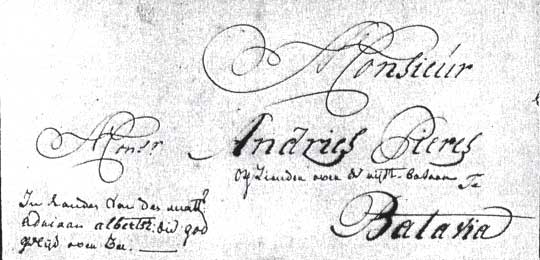
The earliest known letter from Ceylon to Batavia (in Indonesia), April 1757, whilst Ceylon was under Dutch rule.
In 1795 the Dutch were expelled by the British and the Maritime Provinces were initially administered by the British East India Company. Two years later Ceylon became a Crown Colony.
The first Postmaster General under the British was Antonio Bertolucci who was appointed in 1802.
A soldier’s letter dated 1809 to the United Kingdom marked Colombo/Post Free was illustrated in Robson Stamps and Encyclopedia of British Postage Stamps and is one of the earliest letters discovered.

Colombo to Belgium 1883. Carried by P&O ‘Ballarat. Left Colombo 7/2, Aden 15/2, Suez 15/2. Overland to Alexandria
P&O ‘Mongolia’ 21/2, arrived in Brindisi (Italy) 25/2.
The postage rates to the British Colonies were in a period of slow evolution.
Most of the mail still was official and in 1812 regulation regarding such use were adopted. Some governmental officials were entitled to send and receive public and private letters while others were limited to public correspondence.
In 1813 new postage rates to specific places and weight categories were listed. The heavier letters were called packets and the ships, which carried them generally known as Packet Boats.
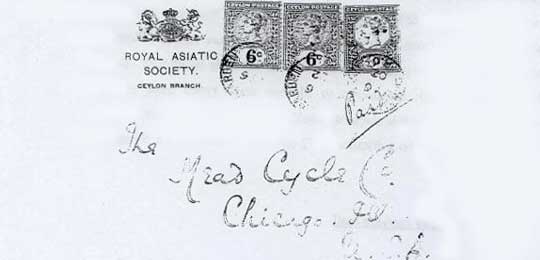
Mail from Cinnamon Garden, Colombo to Chicago. Carried on P*O ‘Australia’. Left Colombo 9/5, Aden 15/5, Port Said 20/5
carried through to arrive at Brindisi on 22/5. Mail arrived in London on 24/5, thence by trans-Atlantic steamer to USA.
Mail to the East was carried by ships of the East India Company called East Indiamen, H.M. Ships and privately owned vessels. A uniform rate was introduced in 1815. A letter posted in London took about 5 months to reach Ceylon. Due to the delay in a sailing ship moving out to sea requiring a westward wind to get out of the Thames, and then down the English Channel with a easterly one. London to Falmouth could take up to 10 days. As such mail was collected and deposited at Falmouth.
The packet service was abolished in 1819 and replaced by the India letter service. The letters were charged internal postage to the port of exit, sea postage, and then internal United Kingdom postage from the port of entry to the destination.
Developments inside Ceylon were progressing and Post Offices were established in the Provinces. In 1832 a Mail Coach Service was established between Colombo and Kandy and between Colombo and Galle in 1838. In 1836 there were 12 Post Offices with a clerk and 30 with Post holders.
The Galle Royal Mail Coach Service was started on 2nd July 1838. The proprietors were Mrs Johanna Morris, Dr P.D. Anthonisz, Henry Andre, and Manager W.F. Jansz.
The booking office was No. 44 Pedlar Street, where the Manager W.F. Jansz lived.
The two horse coach left Galle at 6.00a.m. reached Colombo at 4.30 p.m. There was night mail Coach each way starting at 6.00p.m. The coach was ferried across three rivers at Gintota, Bentota and Kalutara and each time the coach had to be un-harnessed. There are accounts of the coach ride in books on Ceylon. One is reported in ‘Ceylon, off the beaten track’ by W.T. Keble.
Peninsular & Oriental Steam Navigation Company
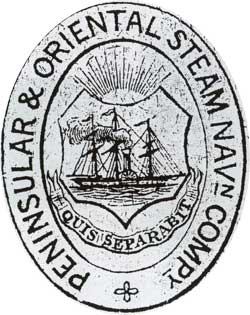 There were rapid changes in the United Kingdom in the 1830’s and 1840’s. These changes are closely tied in with the development of the Company, which came to be known as the Peninsular and Oriental Steam Navigation Company.
There were rapid changes in the United Kingdom in the 1830’s and 1840’s. These changes are closely tied in with the development of the Company, which came to be known as the Peninsular and Oriental Steam Navigation Company.
The story of this Company commences with two individuals, Brodie McGhie Wilcox and Arthur Anderson.
They concentrated on trade with Portugal and Spain (Thus the name peninsular from the Iberian Peninsular). They ran guns and ammunition in support of Queen Maria II of Portugal and the Spanish Crown when they faced civil unrest.
They received the right to fly the Royal Colours of these 2 countries. Thus the Blue and White of the Portuguese House of Braganza and the red and gold of the Spanish Bourbon rulers are used as the company colours in their flag up to this day.
In 1834 they along with others formed the Peninsular Steam Navigation Company. They ran a regular service to Vigo, Oporto, Lisbon and Cadiz. They extended the service to Gibraltar. Unlike the sailing ships, the steam ships no longer had to depend on the vagaries of the weather. Thus a regular timetable for sailing was available for the first time. In the past the sailing ships could not guarantee a sailing date let alone the arrival date, and all dates carried the qualification “wind and tide permitting”.
In 1836 an important development took place. The responsibility for sea mail was transferred from the Post Office to the Admiralty. The Admiralty called for tenders to transport the mail. The mail carried so far by the packet ships run by the Post Office were sailing ships and were unreliable. Merchants wanted a good commercial carrier for regular mail. The company won the contract in 1837 amounting £29,000 and provided it with financial stability. The signing of this contract is recognised as the founding of what became the P&O Company. This was made possible by joining forces with Richard Bourne whose family already had a contract to distribute overland mail by coach in Ireland and ran a Steam ship line called the Dublin and London Steam Packet Company.
The first ship of the new P&O line the Don Juan was ship wrecked, off Tarifa, on it’s maiden voyage. The passengers and the mail were however saved.
The mail to the East was carried by East Indiamen around the Cape of Good Hope. However now a new route was available.
They were taken by Steamship to Gibraltar. From there by His Majesty’s steam packets to Alexandria in Egypt till 1839. In 1839 there was an arrangement with the French Government for the letters to be taken to Marseilles over land and from there to Alexandria.
However, the British Government did not trust the French with its diplomatic mail. The Government wanted a service that would take the mail in British ships, stopping only at British Ports. The company now accepted the challenge but had to grow very rapidly in ships and capital. This it did by setting up a limited company incorporated by Royal Charter in December 1840.
From Alexandria in Egypt, the mail to the East was up till now in the hands of the Honourable East India Company.
They had a monopoly on the route between Suez and Bombay.
From Alexandria to the Suez at the Gulf of Suez, which opened to the red sea the route was developed by Thomas Waghorn. There were 2 routes in existence. From Alexandria to Cairo partly by a small canal, and from Cairo across the desert to Suez. This was the route taken by the mail, with camels used to carry the burden. Passengers however took the route along the Nile from Cairo to Luxor and from there across the desert to a small Red Sea Port of Quseir. This allowed them to enjoy the pleasures of seeing the ruins at Luxor.
P&O was interested in expanding their service to cover the Eastern mail route. This was initially to run a service from Suez to Calcutta through Point de Galle in Ceylon.
The first such ship was the Hindustan, which began Calcutta/Suez sailing in 1843. This was followed 11 months later by another ship ‘Bentinck’ named after Lord William Bentinck a former Governor General of India. A third ship ‘PRECURSOR’ was acquired for the service.
Thus at this time the P&O had two halves each serving either end of what would in future be the Suez Canal.
The mail contract was still controlled by the Admiralty and it was still in charge of the mail and sent a retired naval officer on every ship to look after them. This man had authority to over rule the captain. He could order the ship to sail the moment mails were on board. Sometimes across the overland part of the route, the mail arrived before the passengers. The passengers would then have to wait for the next ship. The responsibility for mail contracts was handed back from the Admiralty to the Post Office in 1861.
For philatelic buffs it would be of interest to note that in 1870 mails that had gone overland to Marseilles were diverted to Brindisi in Italy because of the Franco Prussian war. From Brindisi the mail was carried to Egypt by the Adriatic & Oriental Company of Italy. After the opening of the Suez Canal there was an accelerated mail service to Europe from the East via Brindisi.
The opening of the Suez Canal in 1869 allowed the 2 parts of P&O service to be connected but required new ships which could now travel from London to the East. It also meant that ships could be based and operated from the U.K. From 1841 onwards, P&O had been using Southampton as a port for its mail and passengers.
By 1881 mail was going overland via Brindisi and the passenger terminus moved to London and Southampton ceased to be a port of call.
A new word was added to the English language, POSH which stood for “Port Out, Starboard Home”. The letters POSH were stamped on the tickets on those who could afford to select their cabins on the Port side on the outward passage so that they would be in the shade on the hottest part of the journey down the Red Sea and Starboard side on the voyage home.
The Eastern route between Point de Galle, Singapore/Hong Kong had already commenced in 1845. It used 2 ships at the start. The Lady Mary Wood and Braganza. Incidentally, Lady Mary Wood was used to ferry troops from India to control the 1848 rebellion in Ceylon.
P&O ships took part in freighting in opium to China and taking silk out.
The route was connected to Shangai in 1846 and Bombay in 1847. In 1852 P&O was granted a contract for mail service from Singapore to Sydney using the ships CHUSAN and FORMOSA. The development of its service to Australia is another story.
P&O also had regular contracts to transport Government troops. It was used to transport prisoners in the Boer war (1899-1902). A number of these prisoners were camped at Diyatalawa and Ragama.
Some ships of P&O were named Ceylon. Ceylon I, a passenger liner (1858-1881) was sold to the Ocean Steam Yachting Company and because the first vessel to cruise round the world, Ceylon II a General cargo liner 1894-1913 was sold off. It ended up with the French Government and was renamed Depute Pierre Gouzon. In 1917 it was torpedoed and sunk by the German submarine U103 in the Bay of Biscay.
An Iron Screw Steamer COLOMBO (1853-1862) was sunk in Laccadive Islands while on a voyage from Galle to Aden.
Connection with Galle
The connection of P&O lines with Galle was established very early. Steam ships depended on coal. Coal had to be brought in coaling vessels and coaling stations established at different points on the route. Provisions had to be organized and commerce flourished in Galle. This brought with it a generation of entrepreneurs and much wealth.
The first agent for P&O in Galle was Thomas Twynam. On his retirement in 1850 Capt. Francis Bailey took over and served till the P&O Office shifted to Colombo in the early 1880’s
Norah Roberts in her book “Galle as quiet as asleep” gives an account of the house built by Francis Bailey. Closenberg or Cliff Citadel dates back to 1719 when the Dutch built a small fortalice on the promontory. In 1861 Francis Bailey built a house and called it Villa Marina after his wife. The tops of the doors were embellished with the P&O Crest of the rising sun carved in English Oak. An extra large ornate oak crest tops the heavy beam across the fernery in the back verandah. Capt. Bailey sold this house to the P&O Company but continued to live there as their agent till the headquarters of the company moved to Colombo. A summer house was built at the end of the promontory, and here a flagstaff used to fly the P&O flags.
The well known painting by Capt. Charles O’Brien of COB’s Gap fame shows the Fort of Galle from the P&O station in Closenberg Island.
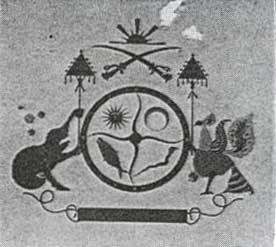 |
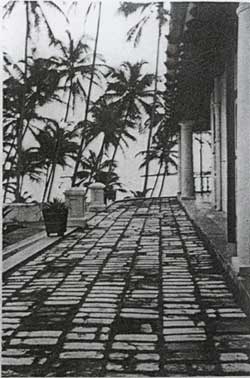 |
| The family crest of the Perera Abeywardena found in the front verandah. | The palm fringed pathway leading to the Summer House which in the time of Capt. Bailey used to be a signaling post. |
In 1889 it was bought by Simon Perera of the famous Perera-Abeywardena family. Pat Williams an authority on Galle has kindly given me the following information on the Perera-Abeywardena family which was strongly linked to the P&O Company since it’s inception. He has provided the photographs of the family Coat of Arms and pictures of the house. The Coat of Arms carried emblems such as the peal umbrella handed down to members of the clan by the Sinhala Kings.
Emmanuel Perera-Abeywardena or Manuel is the first recorded ancestor. His son Christopher married Dona Gimara Silva whose family owned a fleet of fishing and other vessels. Christopher obtained a contract with P&O Steamship Company to handle cargo especially coal and rice. His sons continued the business. One son, Simon bought ‘Villa Marina’ and the house was renamed Closenberg.
Another connection with Galle and Postal History was the pigeon post between 1850 and 1858 established by the Ceylon Observer. The mail ships brought the latest news despatches and these were sent to Colombo via pigeon post. The pigeons were housed at the Galle lighthouse. Each bird carried enough manuscript to fill one small typed page of the newspaper. It is said that the birds could, in good weather conditions fly from Galle to Colombo a distance of 72 miles in 45 minutes, i.e. 96 miles per hour.
Other shipping lines carrying mail
To complete the story there were other shipping lines that carried mail.
British India Steam Navigation Company ran a daily service between Tuticorin and Colombo. On these boats, Calcutta mails were carried to Colombo and this service extended to Mauritius.
Bibby line owned by Messrs Bibby of Liverpool ran a service outward from Liverpool to Marseilles and hence to Colombo and Rangoon. They also carried mail. The local agents were Carson and Company.
Thus the overseas mail service from Ceylon to London and also to the East was closely tied up with the great shipping companies of the time, especially that of P&O Steam Navigation Company.
Introduction of Air Mail changed all that, and that is another story.

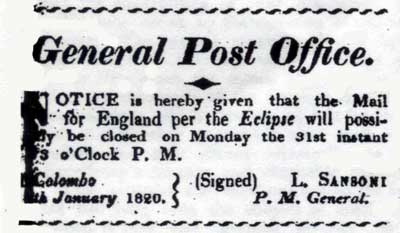
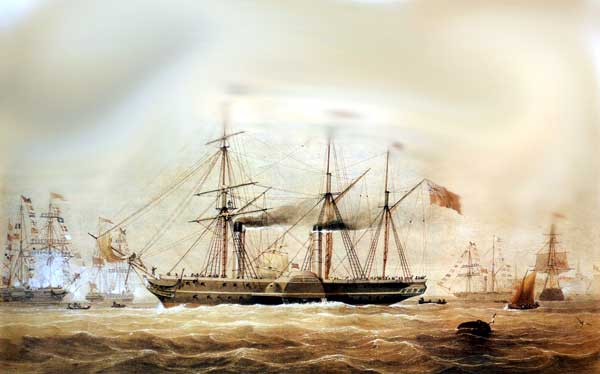
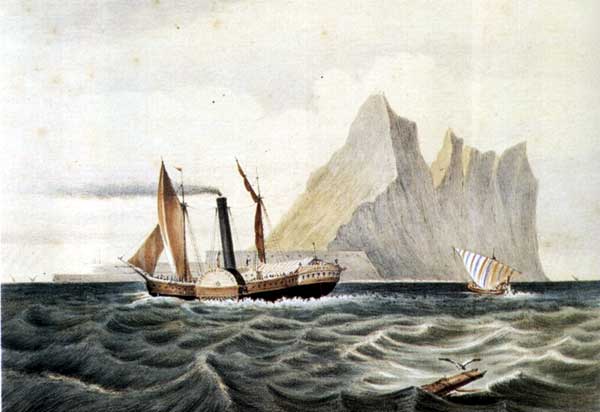
This article first appeared in the ‘Ceylankan’ the Journal of the Ceylon Society of Australia, and subsequently in the Sunday Island of 14th October 2001.